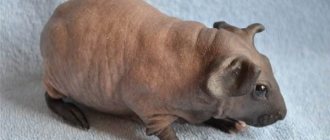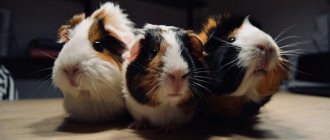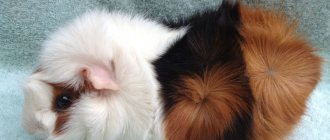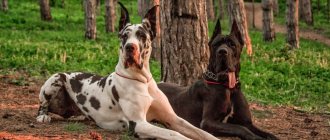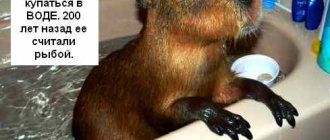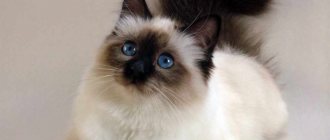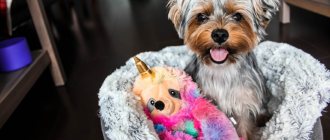The name of the largest guinea pig in the world
The largest guinea pig in the world is called "cooey". Its volumes can be compared with the dimensions of an adult rabbit. In Latin America, such a rodent is even considered a farm animal, the meat of which is used in the food industry. In Europe, this pig has a completely different attitude: everyone considers it a pet, although this type of rodent is rarely seen in our apartments.
You will find domestic cuys in any house of the Quechua Indians: there the pigs move completely freely under the feet of their owner. But in Peruvian countries you can still find herds of wild guinea pigs. They especially love abandoned ruins and mountainous areas.
Features of reproduction
Kui are very prolific. Females are good mothers and are able to feed up to 12 cubs, having only 2 nipples.
Cuis are ready for reproduction at three to four months. Most breeders prefer to cover females already in the first heat, since there is a high risk of adult obesity and the inability to produce offspring in the future. Maintaining a regular diet and a long walk can solve this problem. The average gestation period for a giant guinea pig is 54 - 56 days. The weight of newborn piglets ranges from 80 to 250 grams.
Description of the Kui breed
Giant pigs are the second large relatives of ornamental cavias, which have a similar structure, although they are inferior in size to large capybaras. Guinea pig cubs of this breed weigh only one hundred to one hundred and fifty grams. Already from three months, female kuya can give birth to offspring. The body structure is similar to that of a decorative guinea pig: the animals have a characteristic head with intelligent eyes, rounded ears, as well as a short neck and muscular chest.
Lifespan
All Kui pigs have a short life span: no more than three years. This is due to their tendency to heart diseases that develop against the background of obesity. Excessive load on the animal's cardiac system and skeleton leads to joint problems.
The life of rodents can be increased through selection. With proper care, the pet can live up to six years. But such a figure is more likely an exception to the rule than a pattern.
REFERENCE! Despite the fact that in our country the Kui is designated as a separate breed, it is not one. In Europe, all large-sized pigs are designated under the name "cui". Their breed can be any.
Appearance and dimensions
This species of guinea pig has a massive skeleton and a wide skull. Quite often have extra fingers: this defect is called polydactylism. The unique feature does not bother the animal at all. Representatives of this breed weigh from one and a half to four kilograms. The tail is completely absent. The length of the body of the kui is about forty centimeters.
As a result of selection, two subspecies of kui were bred:
- Creole (distinguished by a wide forehead, elongated muzzle and innate nervousness);
- improved (they have a wide skull with a massive forehead, such animals rapidly gain weight and by the age of six months can weigh up to four kilograms).
The improved breed is further divided into several subtypes:
- English (distinguished by a short and smooth coat of various colors);
- Abyssinian (have a large number of vortices);
- Peruvian (a very cute breed, thanks to its long, smooth coat);
- merino (distinguished by its massive body and tousled wool).
Coat color
The coat of the kui can be either soft or coarse, medium or very long, curly and straight. Guinea pigs have quite a variety of colors; Most often, several colors are mixed here:
- brown;
- sand;
- white;
- black;
- grey;
- piebald;
- chocolate;
- ginger.
Kuya has a difficult character
Guinea pig weighing 4 kilograms? Yes, there are such things!
The appearance of ordinary smooth-haired guinea pigs has not surprised anyone for a long time. These cute rodents are often given to children as their first pets. However, there is a variety that delights even brutal and imperturbable men. This is a kui, a giant guinea pig that weighs up to four kilograms and is up to 50 centimeters long. Impressive, isn't it? Now we’ll tell you in more detail about these cute giants, what they eat, what kind of cage is needed and how to breed kuya at home.
What is kui
In its homeland in South America, this type of guinea pig is classified as an agricultural species. On other continents, these huge rodents are kept at home as pets. In nature, kui live in flocks of 10 or more individuals, subordinate to the largest male. An interesting feature is the Kuya’s tendency to polydacty; many individuals have more fingers than normal, but this does not bother them at all. By nature, these pigs are not the most pleasant. In most cases, they are quite timid, distrustful and not affectionate. When kept in a group in a small room, females become quarrelsome and easily get into fights with their own kind.
How to keep Kui pigs at home
When keeping a cage, we select a cage taking into account the size of the pig. If your plans do not include breeding such a rare breed, then the animals are kept alone, or they are adopted as same-sex ones. When keeping an enclosure, the living part is separated from the walking part, and the second should be as spacious as possible. Be sure to observe the temperature regime; these cute giants live best at 16-18 degrees Celsius. At lower temperatures, pigs begin to get sick and waste away. To simplify the work of cleaning the cages, a tray is placed in the corner, to which the cows very quickly get used to it.
What to feed kui
Given the tendency of pigs to quickly gain weight, a diet for them is selected with the least amount of calories. Unsweetened vegetables, fruits, branch food, fresh grass and hay are the best option. All flour products in the form of crackers, grain mixtures and animal feed are strictly prohibited. Access to water must be free.
Breeding Kui pigs
This variety is a fast-ripening variety; at 3 months the cuja are already ready for mating. It should be borne in mind that the older and larger the pig becomes, the more difficult it is to obtain offspring from it. Severely obese individuals are unable to bear offspring, and their pregnancies are often fatal. And one more subtlety that is important to know: this species under no circumstances interbreeds with smaller ones! Such amateur “selection” can lead to the appearance of animals with various anomalies and propensities for diseases.
And there is one more thing you need to know before you decide to buy such an exotic pet: kui has a very short lifespan. Its duration rarely exceeds 3 years, and with severe obesity of the animal it is significantly reduced. And when cages or enclosures are not cleaned properly, a strong, persistent odor appears, which is almost impossible to get rid of in the future.
Subscribe
to our channel and read new articles, blogs and topics daily.
Our VKontakte and Facebook pages. There are also a lot of interesting things there!
Some images on our channel are taken from open sources, Yandex Images and social networks.
Source
Character traits
Kuya has a difficult character: such animals are very shy and nervous; hostile towards other pets. They practically do not get along with their relatives: if the owner decides to keep two or three females in one cage at once, then nothing will come of this idea. Guinea pigs will fight quickly: their battles often end in severe injuries and even death.
It is impossible to be offended by animals for their harsh disposition. Indeed, in the wild, such rodents must always keep their eyes open. Even experienced breeders cannot boast of friendship with kui.
Is your guinea pig friendly?
Habitat and behavioral characteristics
In the wild, the largest guinea pig in the world is found in the tropics of South America and the Andes. She is a direct descendant of the Guinea pig.
The animal is land-dwelling, but prefers to settle closer to a body of water. Indeed, in case of danger, a river or lake is almost the only place where a capybara can hide. And she has plenty of enemies - these are wild dogs, and cat predators, and snakes, and other wild animals of the tropics.
They feed mainly during the day, but if they feel threatened or someone is bothering them, they are quite capable of searching for food at night.
They live in small groups, the “family” usually includes from 10 to 20 individuals, over which the male leader dominates. In total, there can be up to five males in the group, but anyone who encroaches on the role of leader will certainly be kicked out in disgrace by the existing boss.
Each herd is assigned its own territory, into which strangers are not allowed. They mark it with special pheromones located in the nasal and anal glands. The size of the family depends on the aridity of the area: the higher it is, the more family members there will be.
Communication in the group occurs through whistling.
Conditions of detention
This animal is rarely seen in residents' homes. This is due to the complex nature, short life span and lack of purebred representatives of the breed. Under no circumstances should large cuis be mixed with representatives of other breeds for procreation. This will lead to abnormalities in the cubs: the rodents will become very sick and may not survive. They are unpretentious in care: they can easily run across the floor.
Cell
The housing for the kui must be spacious; this is explained by its dimensions. Sawdust is used as bedding; They are best purchased at a specialty store. Don't forget to create a pen for your rodent to roam!
The pet's house must contain:
- drinking bowl for water;
- feeders for dry and natural food;
- pebbles for grinding down stones and teeth;
- toys and hammocks for entertainment (but do not clutter the cage, the animal needs space).
Provide your pet with good lighting: this will prevent it from causing stress; protect the cage from drafts. In the summer it will be good to expose it to fresh air.
Care and hygiene
Be sure to take care of your pet's fur and claws. The guinea pig is bathed once every two weeks. A special shampoo is used for this purpose. Nails need to be trimmed every six months. Here you can’t do without special tweezers.
Several times a week, throw out the bedding from your pet’s cage and replace it with new ones. Then you won’t have to deal with the persistent unpleasant odor emanating from the animal.
REFERENCE! This animal is not at all suitable for those who have children. Firstly, kui are quite heavy. Secondly, the cry of a child can lead to aggression on the part of the guinea pig. Kui have no sense of attachment to humans. Always buy a small specimen so that you can accustom it to yourself from childhood.
Diet
Feed the guinea pig in moderation, otherwise he will quickly gain excess weight . The amount of food is calculated based on the weight of the pet. The diet should include high-quality plant foods:
- hay;
- vegetables (potatoes, beets, turnips, cabbage);
- fruits (apples, pears, watermelons, melons);
- greens (dill, spinach, parsley);
- tree branches.
ATTENTION! It is forbidden to feed kui pigs with cereals and mixed feed. This type of food contributes to obesity.
The breed came from Latin America
Features of keeping giant pigs
Kui are prone to obesity, which contributes to the spread of cardiovascular diseases. And for those who want to keep a kui as a pet, you need to carefully monitor its diet. Only fresh fruits, vegetables and hay. It is strictly forbidden to feed the kui with mixed feed and grains.
Kui is an ideal option for nurseries. The female is capable of feeding about 12 babies. As early as four months, pigs can be mated. It is very important that the female becomes pregnant in her first heat; in the future, there is a risk of obesity, which will lead to the inability to produce offspring. The female carries her baby for about two months. At birth, babies weigh 80-250 grams.
The largest guinea pig in the world
The breed originates in Latin American countries (Colombia, Peru, Ecuador). Initially, the Kui lived in mountain ranges and among rocks. Individuals gathered in packs: the largest and strongest male was chosen as the leader.
Kui are beginning to be actively used in industry, using their cheap meat, wool and even droppings. For residents of the countries mentioned above, the meat of giant guinea pigs is as familiar as chicken meat for us. Their clean meat is purchased by local restaurants; Sausage and kui stew are supplied to stores. And leather is used to make shoes, bags and wallets.
The Incas even had a saying: “If you grow a qui, you eat well.” Peruvians consume more than twenty-two million guinea pigs per year.
The ancient ancestors of rodents were the size of a bull and weighed up to seven hundred kilograms. The Incas were the first to domesticate guinea pigs: for them they were a source of valuable meat.
The people of the Mochica culture deified these animals, worshiped them and created works of art depicting guinea pigs. Cui has become firmly entrenched in Peruvian culture and was even immortalized in Leonardo de Vinci's famous copy of The Last Supper.
Choosing and arranging a home
Keeping a kuya is not much different from keeping other guinea pigs, but the size and character of the animal should be taken into account. Females do not tolerate being around very well; they can start a fight, but, despite their character, they do not tolerate loneliness well. Males tend to fight for territory with competitors. Therefore, it is important to choose a cage that is spacious enough and well equipped for them. If you have space, it is better to give preference to an aviary
What should a home be like for a kui?
It is best to arrange an aviary for the kuya instead of a cage, even a spacious one - so these large rodents are well suited for owners of private houses. If you decide to go with a cage, then choose an option with a plastic tray that can be pulled out and put back. The height of the cage should allow them to stand on their hind legs.
A house in a cage, like for hamsters, is not suitable for guinea pigs, otherwise these solitary animals will spend all their time in it and will never become tame. In an apartment, you should not have more than a couple of animals (preferably same-sex).
Important!
The cage or enclosure should not be in a draft, near heating radiators or in direct sunlight.
The location of the home should have good lighting. The optimal temperature for kui is between 16–20 °C. These rodents do not tolerate heat and temperatures below 10 °C well. In summer they can be kept in cages (aviaries) outside.
Accessories
The following cage accessories are available for purchase:
- drinker, preferably nipple;
- two feeders - for dry and green food. For hay, it is best to equip a special hay barn;
- flat pebble for grinding claws;
- salt stone or mineral salt wheels;
- tree branches. It is best to choose fruit tree branches;
- hammock, shelves, manholes (optional). You should not overload the cage with such elements, as these rodents love space. In addition, they are quite large and can get stuck in a hole.
Home keeping kui
Due to their bad temperament, the large Kui guinea pig is rarely kept as a pet. It is kept mainly to obtain meat, skins and plant fertilizer from rodents.
join the discussion
Share with your friends
Guinea pigs are considered one of the most popular pets. You can find them either at bird markets or in pet stores. However, these animals will be completely outbred. And for those who want to breed them, this is unacceptable, because the offspring can be unpredictable.
Therefore, it is best to buy pigs from breeders who have all the documents confirming their origin. Today there are many specialized clubs where you can buy guinea pigs with good pedigrees. There are more than 80 types of breeds, which differ in both the length of the coat and its structure.
Shorthair
Such animals are distinguished by short hair, the length of which does not exceed 3 centimeters.
Satin
The fur of these pigs is silky and pleasant to the touch. It fits tightly to her skin. Their color is quite varied and can be either one-color or two-color.
Crested
This breed of pigs is distinguished by the fact that it has a crest on its head. It is located between her ears and eyes. They can be divided into 2 subspecies: English and American. They differ only in color. American guinea pigs are completely monochromatic and have a white crest on their heads. English subspecies are only monochromatic.
Abyssinian
This pig breed is considered smooth-haired. However, its fur is not located in one direction, but is collected in separate tufts. There are no more than 8 of them on the animal, but they are all evenly distributed on the sides.
Their body is muscular and long, but their legs are short and straight. The Abyssinian's coat is very hard and does not exceed 3.5 centimeters. It often happens that they suffer from obesity or various heart diseases.
A characteristic feature of this pig breed is considered to be very hard and wavy fur. It all stands upright and looks like fluff. Rexes come in different colors. In addition, small children love them very much.
Teddy
The breed received this name due to its incredible resemblance to small bear cubs. Teddy fur is very soft to the touch. Its length does not exceed 2 centimeters, so it always stands upright. Their eyes are large and very expressive. The color of the teddy is quite varied. It can be one-color or two-color, for example, the pig is white, with black or brown spots.
Despite their resemblance to clumsy bears, these pets are distinguished by their energy. They love to run and play. At the same time, they do not bite, and show their displeasure only with a menacing appearance. Such beauties live up to 7 years.
